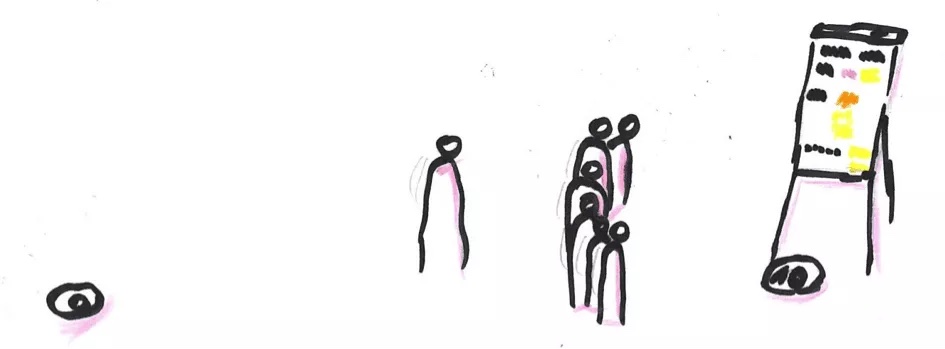In the last guest blog post, I briefly reported on a retrospective that made me think of my first encounter with Ralph and the consequences: “Away with the Ishikawa”.
I’ve now been approached by a few people who wanted to know how the retrospective went. So as not to keep you in suspense any longer, here is the report:
As there was a “flu epidemic” in Nuremberg at the end of January and beginning of February, and I had taken on a few stand-ins, there was little time to prepare for the retrospective in a development team (ET). The room is so small that there is no space to sit down together. The team members therefore have to remain seated in front of their PCs during the retrospective. In the middle are the PO and I, as the moderator, with a flip chart.
How had I prepared myself?
- Read Veronika and Ralph’s book again
- Flip chart with text prescribed (post-its and pens are available in the team room)
We want to achieve this here and now:
So that:
Sequence of the retrospective:
The flip chart is in the middle, the first sheet is blank (the prepared sheet is the second sheet)
1. Positive opening
What did you do well?
(with two rounds) [approx. 7 min]
2. Topic
What topic(s) should be addressed here today to make this retrospective worthwhile for you and the team?
The members of the development team and the PO write their topics on the post-it’s for the next five minutes. Then, one by one, the members stick the post-its on the first sheet of the flip chart and briefly explain them.
3. Selection
The members prioritize the topics using dot voting: everyone has two dots to assign. The result:
- overarching process topic (5 points) => is handed over to Scrum Master
- retrospective should be sustainable (2 points) => is stuck at the top as a meta-topic
- frequency of refinement/grooming (2 points) => is stuck on the 2nd sheet
4. What for?
The members are now given another five minutes to complete the sentence. All post-it notes are stuck on one below the other and explained straight away.
So that:
… we have a better overview of the upcoming stories
… we can recognize potentially blocking problems and dependencies at an early stage
… we look at the stories in a concentrated and focused way and deal with them
5. What else?
In response to the question
„What else…?“
then came,
we also want to do that:
… prepare grooming appointments without a PO, better penetration of stories
As time is already running out (a good 40 minutes have already passed), I shorten the process a little.
6. Scaling
I put a 0 and a 10 on the floor and place the flip chart at the 10, then I ask the members to line up on this scale:
How confident are you that you will take these steps?
One person is at 7, everyone else is at 8. “Oops” I thought, “so many, so close to 10, I haven’t seen that (often).” So I asked:
What’s gone well so far that you’re at 7?
Answer: “A long time ago, we already had a regular appointment like this, and it worked well.”
Everyone at 8 agreed.
When asked
What do you need, what would have to happen for you to move up a number?
I get the answer: “That we set the weekly series date in Outlook straight away and that everyone joins in.”
The other people then say: “Then we’d go straight to 10.”
No question, the Outlook appointment is created immediately.
7. Conclusion
The team members take their seats again and I ask:
Is there anything else to add?
One person would like us to (still) tackle the other 8 topics that are still on the flip chart. After a brief discussion, in the course of which a review of the previous retrospective results plays an important role, the team decides: “Better to work on just one topic, but do it well”.
The retrospective lasted just under 55 minutes and was awarded 4 out of a maximum of 5 points in the final short assessment.
Addendum: The first meeting (refinement/grooming) has already taken place and was relatively short because there was not much to discuss/clarify.




